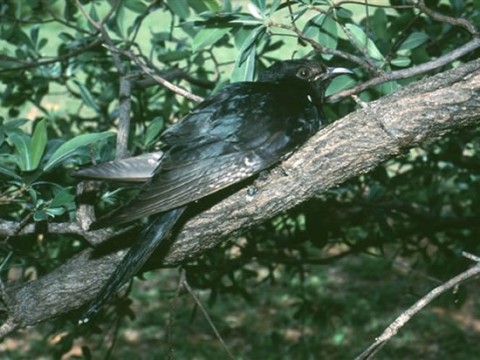It’s not always what you see that is interesting – sometimes it’s what you don’t see, or don’t hear in this case! Up at the Cavern last weekend the Red-chested Cuckoo (Piet-my-vrou) was so conspicuous by its absence (if that makes sense?); not a peep out of it, not a single glimpse of it among the foliage. It was a loud sort of silence, and everyone commented on it.
The cuckoos have obviously read Warwick Tarboton’s book “Nests and Eggs” where he gives the main laying months for the Red-chested Cuckoo as November – December (with only occasional laying noted in October and January). The main hosts at the Cavern are the Cape Robin-Chat and the Cape Wagtail. These birds are recorded as laying year-round but peaking October – December. Perhaps the Piet-my-vrou has evolved to lay in those months when it will have the greatest number of nests to choose from? The cuckoo egg does not match that of the host, but this doesn’t seem to matter.
The Black Cuckoos were loudly vociferous; lots of their ‘whirry, whirry’ call interspersed with the usual ‘I’m-so-sad’ being heard throughout the daylight hours. At the Cavern they choose the Southern Boubou as foster parents and in this case their egg closely matches that of the host. Although October and November are the main breeding months, December to February can be busy too.
Both Diederik and Klaas’s Cuckoos were in full cry over the weekend. The Diederick Cuckoo has a wide range of hosts, including weavers and sparrows and these are in abundance at the Cavern. It is known that there are at least three “tribes” of Diederick Cuckoo and each one lays eggs closely resembling a particular host. Somehow these birds “know” which nest to choose in order to match their egg to that of the host and not risk their egg being evicted. A wonderful example of the power of evolution.
Klaas’s Cuckoo is another of the gorgeous shiny green cuckoos of the genus Chrysococcyx (the Emerald Cuckoo is the third member of the genus) and its chosen hosts are sunbirds, batises and warblers. As with the Diederik Cuckoo, one egg is laid per host nest and at the same time one of the host’s eggs is removed. All these cuckoo eggs hatch before those of the host and the hatchling simply removes any remaining eggs, thus ensuring it gets all the food. Cuckoo chicks are always much larger than their foster parents and yet they are not recognised as a foreigner. Perhaps the unwary host is proud of its extra large offspring?
Cuckoos are not the only birds that do not build their own nests nor care for their own young. Honeyguides are another group of nest parasites and the chosen host in this case is a hole-nesting bird. Because hole nests are dark places there is no need to match the host’s eggs, but the young parasite has to be very careful when finally leaving the nest as once out in the open, the foster parent can recognise it as an enemy.
The Pin-tailed Whydah (not a favourite with many!) is another in this group and the preferred host in this case is the enchanting little Common Waxbill. The nests of Orange-breasted and Swee Waxbills, Bronze Mannikins and Red-billed Firefinches are also parasitised. There is a different strategy here and the little whydah is raised along with the host’s nestlings. It’s all a matter of having the correct pattern on the inside of your mouth – no match, no food!
Nest parasitism is a strategy that only works because there are a limited number of species unwilling to make their own nests and take on the arduous task of bringing up the kids. Looked at in a cold and clinical way, it is a clever strategy – this way a bird can have many more offspring than would be possible if it had to care for them all itself. Morally bad, but then I don’t think birds have many morals…….

